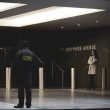U.S. honing nuclear detection at borders
Vehicles passing through a busy border crossing are also subject to nuclear radiation scans. Border officials have been perfecting the use of the devices — even though they are prone to set off alarms for items such as kitty litter, ceramic tile or bananas.
“Nuclear materials such as uranium and plutonium are not the only materials that emit radiation,” Vayl Oxford, who directs the Homeland Security Department’s nuclear office, told a House Appropriations panel this week.
The machines, first installed after the Sept. 11, 2001 terrorist attacks, measure gamma radiation, but cannot distinguish between low levels of gamma rays that occur naturally in innocent materials, and the makings for weapons that terrorists might use.
So the inspectors must pull the truck or container aside for a second inspection with a hand-held scanner, which, at the nation’s busiest ports or border crossings, can lead to backed-up lines that anger drivers and slow commerce.
“Naturally occurring radioactive materials … place an enormous burden on our customs offices, who must respond to all radiation alarms, including those caused by innocent goods,” Oxford told the Appropriations subcommittee. He explained that distance, dense materials like steel and lead, and the speed at which trucks carrying cargo move — about 5 mph — all affect the scanners’ effectiveness.
That’s the dilemma of protecting the United States from nuclear terrorism — a trade-off among accuracy, inconvenience and the expense to taxpayers, The Associated Press reports.
About 900 scanners have been installed at ports and border crossings around the United States. Government officials are working with several companies to develop new nuclear detectors that can actually differentiate the potassium in a banana from that in highly enriched uranium.
Tests being conducted in Nevada this month pit new detectors against the older ones to determine whether the higher accuracy claimed by the makers of the new machines is enough to justify their higher cost — around $377,000 each, more than six times the cost of the older models.
Later this spring, the new machines will undergo a real-world test on the New York waterfront so Customs officers can judge for themselves if they are an improvement. They are also to be used in similar tests along roads leading to the city as part of an effort to set up a protective perimeter starting in 2008.
Last October, the congressional Government Accountability Office reported that the new machines, touted as having fewer false alarms, showed a frightening incidence of “false negatives” — meaning the scanner either misidentified the material as nonthreatening, or failed to detect it at all. That danger is particularly high if the nuclear material is placed beside a nonthreatening substance such as kitty litter, the report said.
To test the new machines, the nuclear office sent trucks carrying radiological materials on 7,000 runs down a row of scanners developed by 10 companies. They chose three finalists whose models are still under evaluation.
Oxford will recommend to Homeland Security Secretary Michael Chertoff following this month’s tests whether the machines should be certified for use. The agency plans to spend $80 million this year to buy 104 of the advanced models, and ultimately wants to put them at 380 border sites. Congress has said that cannot happen until the machines are proven effective, The AP reports.




















